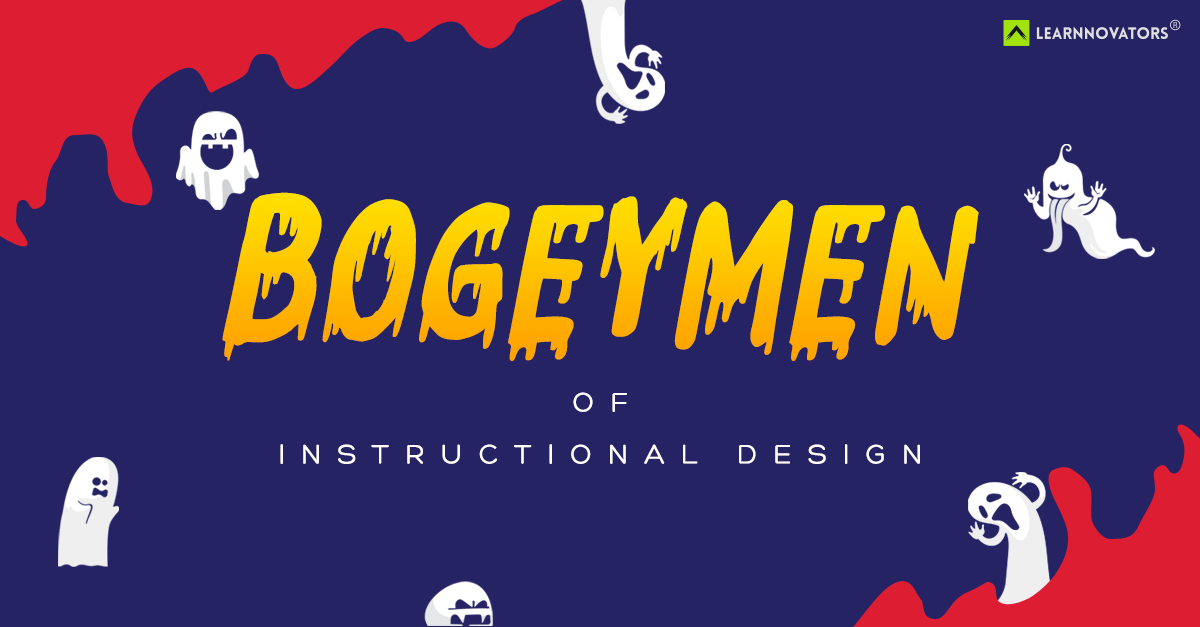I’ve been an Instructional Designer for many years now. I’ll admit we are an imperfect profession. After all, design lives in the space where there is no formulaic answer. And Instructional Designers work with the unknown and the unfamiliar on a daily basis. I think I, and every ID I’ve known, has had that bogeyman image of the kind of ID they didn’t want to be when they grew up!
These bogeymen haunt us and every time we catch a glimpse of their shadow in a project, no matter how experienced we are, we turn pale and hope like hell that that wasn’t a reflection we just saw! What scares an ID you ask? Well, these are my bogeymen…
8. The Oatmeal ID
Starting the list off gently, this designer is not really that bad. They’re just… stolid. Unexciting. Eminently forgettable. You get exactly what you might expect, nothing very earthshaking or awful. You wanted an application training? This is the designer who proposes show-try-test simulations. If instructional design had a color in the course, this designer’s choices would undoubtedly be beige.
At course delivery, you know there will be no nasty surprises. You can bravely poke a spoon in and stir things around. It’s just that… it’s all so gloopy and uninspired and bland, you just don’t feel like trying it even knowing that it might be good for you.
7. The Fairy Godmother
Your wish is her command. She provides fulfillment of direct asks. What she doesn’t do is ever question the basic premise of what you ask for, or try to offer suggestions on a better problem framing. The work is all on you for diagnostics.
And God help you if you happen to not know your mind or be unfamiliar with instructional design! This seemingly peaceful designer can wreak havoc on your course by offering you everything you mentioned, whether or not it all works together, works for the given purpose and context. You know those stories where people walk into traps because of a genie that gives them 3 wishes? This so-obliging designer can become exactly that nightmare.
6. Dr. Jekyll & Mr. Hyde
This is when two-for-the-price-of-one is a deal you really, really don’t want. It’s like working with two completely different designers between design and execution – and the two are apparently not on speaking terms!
You’ll have discussed some critical design points in-depth and agreed to create a certain learning experience with Dr Jekyll, only to find that apparently, Mr. Hyde who worked on your design wasn’t told any of this. Hyde will end up giving you something completely unexpected – and unwanted – and you won’t have a harbinger of things to come until the course thuds on your desk with its nasty surprises.
5. The Droner
The droner is possibly the designer that your learners may hate even more than you do. The droner doesn’t say much in design discussions with you. But given the input content, the droner swings into action, creating copious paragraphs of unwieldy corporatese that has all the personality and sparkle of soggy cardboard.
Now don’t think the droner just copy-pastes your input. No no. The droner has a repertoire: the droner begins with a definition (so useful at the workplace), or a clunky wad of law/regulation and then drones on for pages. A love of locked navigation and audio that recites every word displayed on the page are other scintillating pedagogical choices to look forward to.
4. The Wiki Dump Truck
The WDT designer is the darling of SMEs with no self-restraint. He is more than willing to throw everything and the kitchen sink in the curriculum. No content is too fragmented, tangential, or irrelevant to include. If you happen to slip in an accidental page of a brownie recipe in the middle of a content dump, it will be faithfully produced.
It’s not that the WDT doesn’t want to try: that brownie recipe might well be classified as ‘secondary content’ and made available as a ‘resource’ material or through a click and display interactivity. The WDT just never thinks critically to suggest discarding anything from the curriculum. Ever.
3. The Dilettante
You know the designer who jumps into the conversation with a suggestion for animation in 3D – no, augmented reality – no, virtual reality! – for soft skills or orientation? The Dilettante knows what’s hip, what the buzz in town is about right now and is more than happy to clue you in. The D. will offer you ‘brain-based learning’ or a way to ‘reduce seat time by breaking the curriculum into a series of micro-learnings’.
Just never ask for an actual training approach that makes sense or that’s not based on prevailing fashions. Don’t ask how something will really help or work either. Basically, don’t get bogged down in vulgar aspects like execution viability and pragmatism.
2. Reversi Champion
If you’ve ever played Reversi, you’ll relate hard to this one. Every time a player puts down a coin in Reversi and thinks they’ve captured the board, stabilized their strategy – the other player puts down their coin and completely changes the state of things, bringing you back effort-wise to square one.
You think you’ve commissioned work – hired an expert to get things done. But they’re going to come back to you with requests that actively create more work for you. They’ll sell you a case-based approach even when you’ve given no indication that you have such information to support them. And then when you’re pleasantly interested and give the go-ahead, thinking they’ll drive things, they’ll dump the design burden back completely on you.
1. The Spielberg Special
This is truly the one that horrifies other designers the most. This designer writes a motion picture script for the intro animation, composes the special effects and media first, budgets accordingly… and has nothing to say about the teaching of the course or scaffolding for learning.
You’ll read a heck of a description for the start of the course and then from there things will simple fizzle out like a damp firework. You’ll stare sadly at the training and try to convince yourself that it’s not that bad – because that intro would have cost you a ton of money – but you’ll also never want to show your stakeholders more than that start. In fact, it might be safer to show them the training through just screenshots than risk their seeing the other screens. After all, you’re a kind soul and no one else should have to suffer the anticlimactic heartbreak that you did.
So, which bogeyman did you sight most recently? Did you meet one I’ve not yet worried about being? Do tell – despite my boss waiting in the wings to laugh sinisterly, I’ve such morbid interest!
Written by Mridula R., Principal Learning Consultant @ Learnnovators






